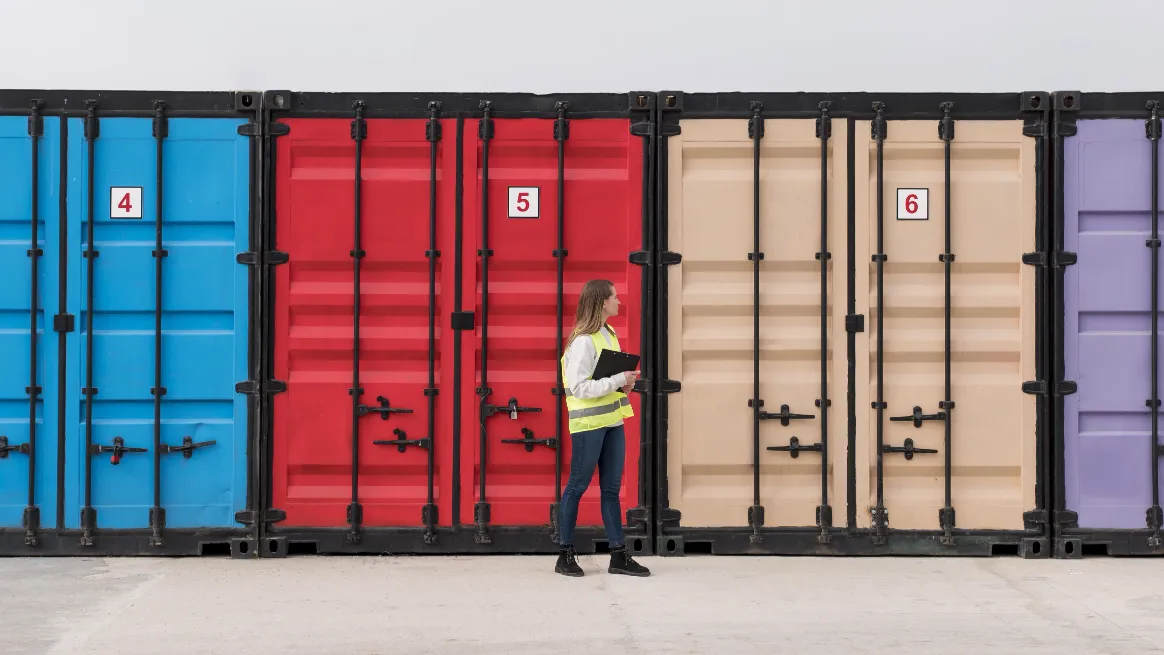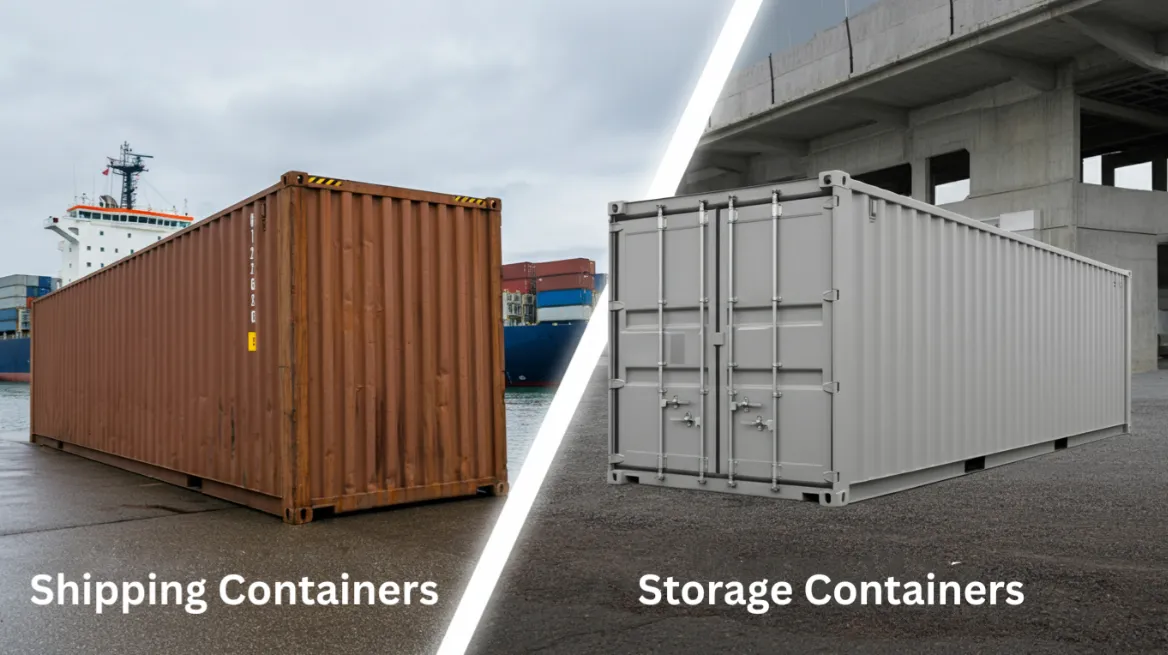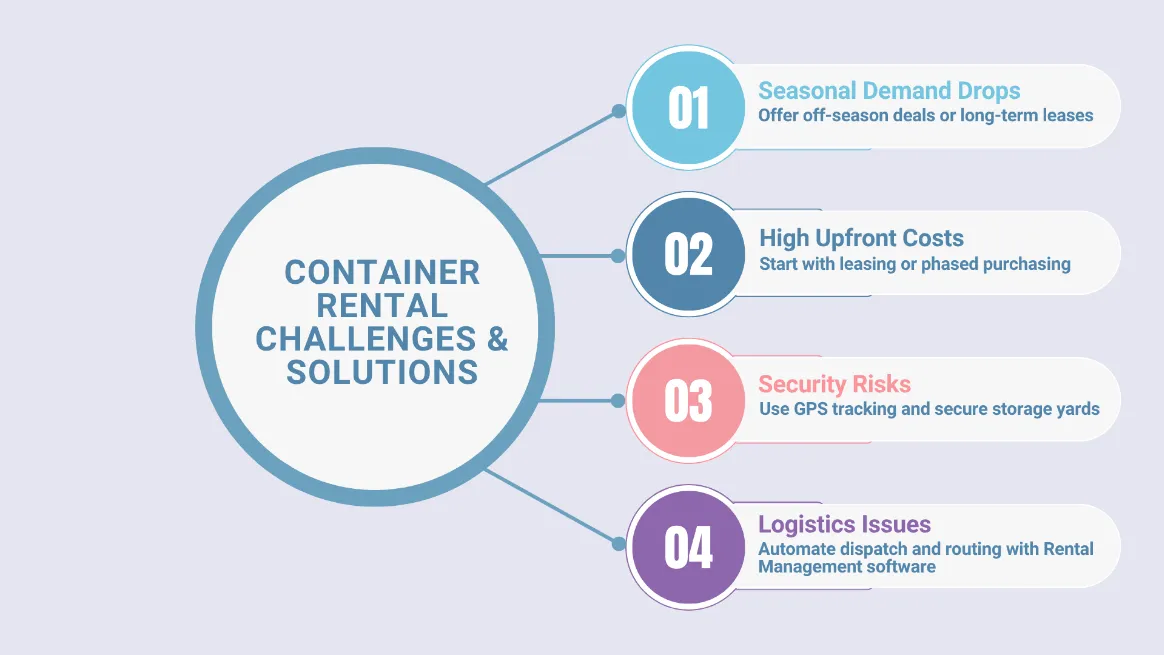Are you thinking about how to start a container rental business? You’ve probably noticed that everyone from contractors to retailers needs extra space. Yes, starting a container rental business can provide a steady income, and you’re on the right track.
The market is growing, with its value expected to jump from $13.23 billion to $21.69 billion between 2025 and 2034. This shows a high demand for flexible storage solutions.
This guide simplifies everything you need to begin. We’ll cover research, planning, finding containers, setting prices, getting licenses, and managing your rentals. Let’s get started on building your plan.
What is a Container Rental Business?

A container rental business provides durable containers to customers temporarily and charges rental fees for their use. These containers offer secure, mobile spaces for storage, transportation, or specialized uses, allowing clients to access essential assets without outright purchase.
These businesses provide containers for rent, manage delivery and pickup, and handle rental agreements. They serve industries like construction, events, logistics, and residential storage, offering flexible and affordable temporary space solutions.
Storage Containers vs. Shipping Containers

Storage containers and shipping containers serve different purposes. Storage containers are stationary and typically placed onsite, while shipping containers are designed for frequent transport by ship, truck, or train.
Storage containers come in smaller sizes (as small as 10 ft) and conditions like wind-and-water-tight (WWT).
Shipping containers are standardized (20 ft, 40 ft, high-cube) and often certified cargo-worthy (CW) for export. These differences impact rental costs, logistics, and setup.
For example, a contractor might rent a 10 ft storage box for onsite use, while a manufacturer leases a 40 ft container to ship goods overseas. Knowing these differences helps you choose the right option and tailor services to your needs.
Here’s a quick table of differences between storage and shipping containers to help you decide
Quick Overview: Storage vs. Shipping Container Rentals
Aspect | Storage Container Rental Business | Shipping Container Rental Business |
Primary Function | Provides secure on-site storage for goods or equipment | Used to transport goods locally or overseas |
Mobility | Stays in one place once delivered (can be moved by truck if needed) | Built for frequent transport by ship, truck, or train |
Size & Certification | Comes in various sizes (10ft, 20ft, 40ft); usually wind- and water-tight (WWT) | Standard sizes (20ft, 40ft, high-cube); cargo-worthy (CW) and export certified |
Pricing Influences | Usually lower daily or monthly rates due to minimal transport and simpler setup | Often higher cost due to transport, handling, and certification |
Example Use Case | Construction firm rents a 10ft unit for on-site tool storage | The manufacturer leases a 40ft container to ship goods overseas. |
Is a Container Rental Business Profitable?

Running a container rental business can be highly profitable with efficient management.
Containers are in demand across industries like construction, retail, shipping, and events. This creates a steady income stream, as more people choose to rent rather than buy.
The global container storage and rental market is valued at about USD 13.2 billion in 2025 and is expected to grow steadily to around USD 21.7 billion by 2034, at an average annual growth rate of 5.8%.
Profitability depends on utilization, delivery costs, and fleet management.
Operators with steady bookings and efficient logistics can see returns of 10–15%, and even higher margins by offering add-on services like delivery or modifications.
Standard containers can be rented for $150–$500 per month, and specialized units like refrigerated or office containers earn $500–$1,000+ monthly.
With proper planning, good maintenance, and smart pricing, a container rental business is a great way to boost your return on investment and secure a reliable income.
Expected Earnings From Different Container Types
Container Type | Typical Monthly Rate | Average Occupancy | Estimated Monthly Profit (per container) |
20-ft Standard Storage Container | $200 – $450 | ~75% | ~$270 |
40-ft Shipping-Grade Container | $350 – $600 | ~80% | ~$360 |
20-ft Refrigerated (Reefer) Container | $800 – $1,200 | ~70% | ~$525 |
Disclaimer: The figures provided are approximate and may differ depending on factors like location, demand, container condition, and delivery costs. Estimates exclude fuel, repairs, and downtime. Always conduct proper market research and consult with a financial advisor prior to investing.
Future Trends in the Container Rental Industry
The container rental industry is changing fast, thanks to technology and a focus on going green.
Smart containers are a big part of this. Valued at $4.17 billion in 2023 and projected to reach $18.58 billion by 2032, these containers use IoT sensors for real-time tracking, temperature checks, and maintenance.
They boost security, cut losses, and make operations smoother, attracting clients needing precise logistics.
Sustainability is another major trend. More companies are choosing eco-friendly options by refurbishing containers, using recycled steel, and adding solar power.
Some are even repurposing containers for things like pop-up offices, showing a shift towards greener and more creative solutions.
Finally, AI and automation are simplifying operations. Rental firms use advanced algorithms to predict demand, optimize routes, and schedule maintenance. This helps them scale efficiently and stay ahead of competitors.
So far, we’ve explored all the basics of the container rental business. Now let’s see how to bring this rental business idea to life.
8 Steps to Start a Container Rental Business
Starting a container rental business involves more than just buying containers. You need a solid plan, the right infrastructure, and systems to protect your assets. The following seven steps will help you launch your rental business.
Step 1: Research Your Market and Choose a Niche

Market research helps you pick the right prices, locations, and containers. Without it, you could waste money and earn little.
A. Study Local Demand
First, figure out who needs containers in your area.
Construction companies need onsite storage, retailers require extra space for seasonal items, and logistics firms use them for overflow.
Even event organizers need them for temporary storage.
Next, see how many people are searching online for container rentals.
Use tools like Google Trends or Keyword Planner to check for searches like “container rental near me.” This data shows you where the demand is highest.
By looking at both online trends and what’s happening in your local area, you can identify patterns.
You’ll learn about busy seasons, popular container sizes, and customer expectations. This research is the foundation for a successful container rental business.
B. Evaluate Competitors
The next step is to research your competitors.
Conduct a business analysis of container rental companies in your target area. Look at their pricing (hourly, daily, weekly) and the types of containers they offer, like standard, refrigerated, or office units.
Also, study their advertising. Are they using local SEO, paid ads on Google and social media, or partnering with real estate agents? Understanding their strategies will help you build your own marketing plan.
Find gaps in their services. Could you offer eco-friendly containers, flexible delivery schedules, or custom modifications for events? These unique offerings can help you stand out. By knowing your competition, you can find your own profitable niche in the market.
C. Define Your Niche
Once you understand the market, you need to find your niche in the container rental industry.
Some business owners focus on renting storage containers to builders and contractors. Others provide shipping containers to manufacturers who need temporary storage or workspace.
You could offer both, but this requires more money and better planning.
Choose a niche that matches your budget and business goals.
A clear focus helps you attract the right customers, set your prices, and market your business effectively. This decision will guide you as you build your container rental business.
Step 2: Build Your Business Plan and Register Properly

Before you launch your first ad or take your first container rental booking, make sure you have a plan and all your paperwork in order. The next steps will help you build that base so your business can grow smoothly.
A. Create a Business Plan
A detailed business plan keeps your vision clear as you grow.
Start by defining your target market, pricing, startup costs, delivery process, fuel expenses, storage yard fees, marketing needs, and your budget for acquiring first units. This gives you a realistic view of your venture.
You’ll need this plan before you list your first unit or build your website. Clear numbers guide decisions and prevent mistakes.
And Good planning helps you stay grounded as demand changes and new costs emerge.
Plus, these documents also help if you’re seeking funding. It proves to investors you understand how to start a container rental business with a structured approach.
B. Register Your Business
Once your plan feels solid, make the business official.
Pick the right structure, LLC, corporation, or sole proprietorship based on your goals. Register your business name, get the proper licenses, and set up organized records from the start.
Plan your budget using strong financial management strategies.
Track expenses, prepare for slow months, and stay ready for unexpected costs like container repairs or fuel price spikes. Staying on top of your numbers reduces stress.
Make sure you follow all tax rules. Register for the right sales tax based on your location and services.
Since these rules vary, a tax professional can help you stay compliant. Good tax practices protect both your revenue and reputation.
C. Check Zoning and Permits
Before you can store or move containers, your yard must follow local zoning rules. Some areas may limit how high you can stack containers, restrict truck access, or require special permits.
Checking these rules early helps you avoid expensive mistakes and ensures your operations run smoothly. It also helps you understand how much space you have for storage, repairs, or staging.
D. Secure Insurance
Insurance protects your rental business from accidents, theft, and unexpected losses. You’re dealing with heavy equipment, transportation, and on-site risks, so proper coverage isn’t optional.
Make sure you secure the right insurance for your rental business.
This shields you from property damage, customer injuries, transportation mishaps, and income loss if operations pause.
With coverage in place, you can grow confidently, knowing a single incident won’t drain your cash flow.
Disclaimer: The content provided here is for informational purposes only and does not constitute professional legal or tax counsel. Always consult a qualified professional.
Step 3: Source Quality Containers at the Right Price

Now that your foundation is set, it’s time to choose the actual containers you’ll rent out. Your buying decisions here influence customer satisfaction, maintenance costs, and your overall profit margin.
A. Buy or Lease Containers
Deciding whether to buy or lease containers is a major financial choice.
Buying gives you full ownership and a long-term asset, but it requires a large upfront investment.
Leasing, on the other hand, has lower initial costs, which is why many new owners prefer it. This option lets you start small and grow at your own pace.
Leasing is a smart way to test your market and understand local demand. Once you have steady bookings, repeat customers, and predictable busy seasons, buying becomes a smarter investment.
The right choice will free up cash for other important things, like marketing and delivery equipment. Both buying and leasing can work, as long as the path you choose aligns with your business goals and growth speed.
B. New vs. Refurbished
New containers look clean, last longer, and attract clients who need near-perfect conditions. They cost more, but offer excellent durability and a stronger resale value. They are ideal for businesses where appearance matters, like retailers or event planners.
Refurbished containers are a cheaper option, perfect for clients who need secure storage over aesthetics. You’ll save money initially, but might face occasional repairs. Managed well, these units can still provide great returns.
C. Find Reliable Suppliers
Your supplier influences your entire customer experience. A reliable supplier will provide clean, strong containers on time.
They should give you accurate information about the container’s condition, help with delivery if you need it, and be able to find containers for you even when they are in high demand.
Before you commit, take the time to read reviews, look at photos of their containers, and carefully check the contract. It’s best to work with suppliers who respond quickly to your questions and guarantee the quality of their products.
When you have dependable suppliers, your customers will trust your service more and are more likely to rent from you again.
Step 4: Set Up Your Yard and Logistics

Before your first container delivery, you’ll need a well-organized yard and an efficient transport system. Getting these right from the start will shape your daily operations and save you time and money.
A. Prepare Your Storage Yard
Your storage yard is your operational hub. Design it for efficiency and safety.
Organize containers to give trucks plenty of room to access and load units easily. When stacking, always follow weight and height safety guidelines to prevent accidents and damage.
Good organization also helps you keep track of units for cleaning, repairs, or upcoming rentals.
For security, install solid fencing, bright lighting for early or late operations, and cameras to deter theft and document activity.
Finally, ensure your yard has proper drainage to prevent rust. A gravel or paved surface keeps the area clean and accessible in bad weather.
These steps will make your yard professional and efficient.
B. Plan Transport & Handling
A strong logistics system turns a complicated job into a smooth routine, making your container rental business far easier to manage.
Once your yard is set, focus on moving containers. Efficient transport directly impacts customer satisfaction. You’ll need trucks, cranes, or forklifts for safe handling.
You can build an in-house team for full control, hiring trained drivers. This costs more initially but offers faster service.
Alternatively, you can partner with external logistics providers. This reduces overhead and helps you scale, but choose reliable partners.
Finally, optimize routes. Fuel and labor costs add up, so make sure to avoid detours and traffic. A strong logistics system makes managing your container rental business much smoother.
Step 5: Develop a Smart Pricing Strategy

As your operations take shape, the next step is setting rates that balance profit and customer appeal.
Your pricing should reflect container type, local demand, and rental duration. You can use competitive pricing, high enough to stay profitable but low enough to attract customers.
Offer options for short-term renters (events or construction) and long-term clients (storage or logistics) to keep units in rotation and ensure steady income.
Clear security deposits and late fees prevent confusion and keep schedules on track.
To boost revenue, consider bundled packaging: combine delivery, pickup, and add-ons like shelving or ventilation for a convenient price.
Value-added upgrades like custom paint or climate control can place your business in a higher pricing tier and help you attract premium clients.
Lastly, adjust rates for seasonal demand: higher during construction season and discounted in slower months to maintain occupancy throughout the year.
Pro-tip: Tools like RentMy can automate pricing updates, track demand patterns, and build profitable packages that keep your rentals booked consistently.
More Profitable
Use RentMy to automate deposits, late fees, and bundled pricing.
- Free trial
- No credit card required
Step 6: Manage Operations and Customers Efficiently

Before your business grows, you need a system to stay organized. Smooth operations ensure on-time deliveries, fewer mistakes, and predictable workflows that your customers can trust.
Digital tools simplify deliveries, pickups, and maintenance. Use calendars and fleet management to assign drivers, track containers, and plan routes efficiently, saving time and fuel.
Accountability improves with proper documentation. Track container conditions, driver activity, and truck usage to stay aligned with regulations and ensure smooth expansion when hiring or adding vehicles.
Regular inspections prevent small issues like rust or dents from lowering your container’s rental value. Automated reminders help you keep units clean and damage-free, ensuring better reviews and loyal customers.
Modern software simplifies container rental management. Features like online booking, real-time inventory tracking, e-signatures, and automated invoicing improve efficiency.
Customers can book and pay online, while you reduce paperwork and double bookings, keeping everything professional and hassle-free.
To get all these tools in one place, you can use a platform like RentMy that handles bookings, payments, inventory, transport scheduling, contracts, and customer updates without multiple apps.
RentMy tracks damage, maintenance, and location in real time.
- Free trial
- No credit card required
Step 7: Market Your Container Rental Business and Drive Bookings

Now that your operations run smoothly, it’s time to get more eyes on your business. Your marketing approach sets the tone for trust, visibility, and long-term bookings. Here’s how to market your rental business to get more bookings.
A. Build a Booking-Ready Website
Your direct booking site works as your home base. It lets customers book without waiting for third-party approval or losing revenue to commissions.
Make sure your site loads quickly, works well on mobile, and is easy to navigate since more than 60% of internet users browse on their phones!
You can build your own website using DIY tools, but platforms like RentMy make the process far easier. You get a ready-made, SEO-friendly site with built-in booking, secure payments, and a clean design that matches your brand, without coding, plugins, or technical setup.
For SEO for your rental business, tools like Google’s “People Also Ask” and Keyword Planner are great starting points. These tools show common customer questions.
Add those questions naturally to your pages, FAQs, or service descriptions. This helps improve your site’s visibility and attracts searchers ready to book.
Sells Your Containers
RentMy gives you fast pages, built-in SEO, and easy payments.
- Free trial
- No credit card required
B. Fine-Tune Your Container Listings
Your profile in the RentMy Rental Directory and other rental sites is your online storefront.
Make sure your listings are clear, with high-quality photos and simple details about your containers. This helps renters decide quickly.
To attract local customers, create a Google Business Profile. This puts your business on Google Maps, shows off your reviews, and provides instant contact info and directions.
A strong profile here can win over renters before they even visit your website.
C. Optimize Your Container Profiles
Paid ads help you connect with people searching for storage containers, construction solutions, or temporary space.
Partnering with event organizers, construction firms, and logistics teams creates steady referral opportunities year-round.
Social media is powerful, with over 5.66 billion people using these platforms daily. Sharing container setups, customer stories, or behind-the-scenes clips boosts awareness and keeps your brand visible.
Email marketing still works incredibly well. It generated $9.5 billion in marketing revenue in 2024. Simple newsletters let you reconnect with past renters, promote deals, and nurture leads who haven’t booked yet.
Loyalty programs turn one-time renters into repeat customers. A 2024 survey shows most U.S. customers prefer brands that reward loyalty.
Offering upgrades, priority delivery, or discounts builds trust and encourages long-term partnerships, especially with contractors who need reliable container access.
Step 8: Scale, Optimize, and Overcome Common Challenges

Once your business is stable, look toward scaling and sustainable growth. Plan to grow, and small steps can lead to big results.
A. Build a Booking-Ready Website
To boost your revenue and market standing, expand your container fleet. More containers mean you won’t lose business by running out of stock.
Begin with standard 20-ft and 40-ft units. Then, add specialized options for higher-value customers. For example, refrigerated containers suit grocery or pharma, while mobile offices appeal to construction or event organizers.
Consider upgrading features like better locks, shelving, insulation, or climate control. These justify higher rental rates and help your fleet stand out.
A varied inventory allows you to serve more needs and reduces reliance on a single client type. This mix makes your business stronger and more competitive.
B. Grow Into New Markets
Diversifying into new markets boosts your rental income and strengthens your brand. Beyond construction, many industries now depend on flexible container solutions.
Retailers use them for seasonal inventory, event organizers for secure equipment storage, and logistics companies for managing shipment surges. Schools, municipalities, and farms also rent containers for temporary needs.
Each market has distinct expectations, valuing speed, customization, or specific pricing. By understanding these patterns and tailoring your offerings, you can boost conversions and justify premium rates.
Entering multiple markets also protects your business from seasonal dips and ensures a steady flow of rentals year-round.
C. Address Common Challenges

As your container rental business grows, new challenges emerge, but practical solutions keep things smooth.
Manage seasonal demand with off-season discounts or by targeting year-round industries like logistics.
Address high upfront costs by leasing containers, financing purchases, or phased buying.
Enhance security with GPS tracking, improved locks, and secure yards.
For operational complexity, use route optimization tools and rental management software like RentMy to automate dispatching, scheduling, and invoicing.
With these systems, every challenge becomes an opportunity to strengthen your business.
Conclusion
And that brings us to the closing chapter of how to start a container rental business successfully. You’ve seen the steps, the challenges, and the opportunities ahead. Now it’s time to turn your ideas into action.
Consistency is key. Use good software, keep your systems simple, and communicate honestly to build a business that customers will remember and trust.
Your next move matters most. Start with one small task, like building your website, finding containers, or setting prices. Every small effort stacks up until your business becomes the real deal.
FAQs
Yes. Container leasing can be profitable because there’s steady demand from construction, logistics, and storage users. It also keeps upfront costs low and scales easily. However, profitability depends on factors like how efficiently the fleet is managed, local demand, maintenance costs, and downtime.
Yes, container homes are generally allowed in Kentucky. However, each county has its own rules. You’ll need to follow local building codes, zoning requirements, and inspection guidelines. Always check with your local planning office before starting a project.
Startup costs can range from $20,000 to $100,000, depending on your inventory size and equipment needs. Expenses may include buying or leasing containers, setting up a storage yard, delivery equipment, insurance, and business licensing. Leasing containers is an option if you want to reduce upfront costs.





